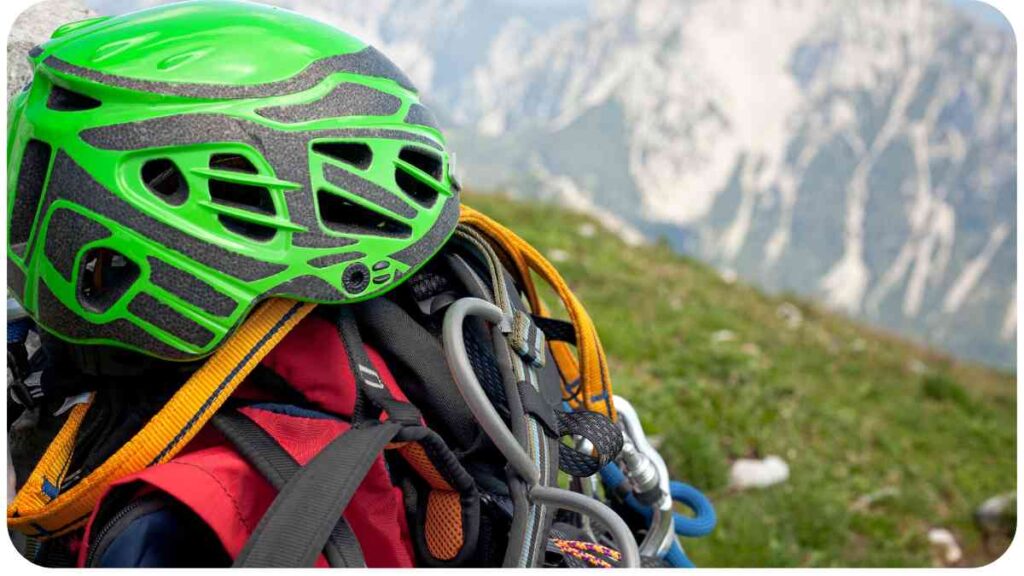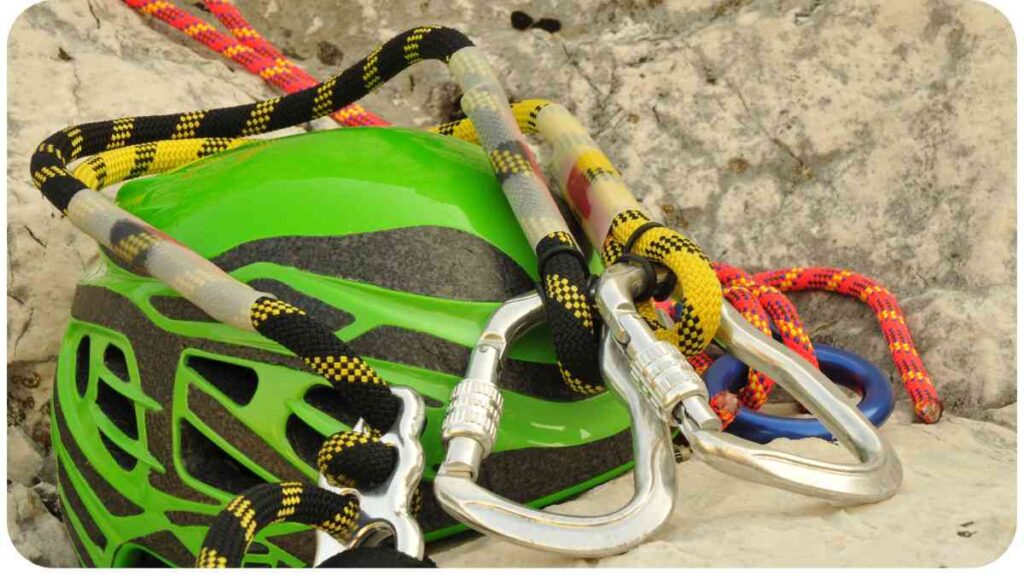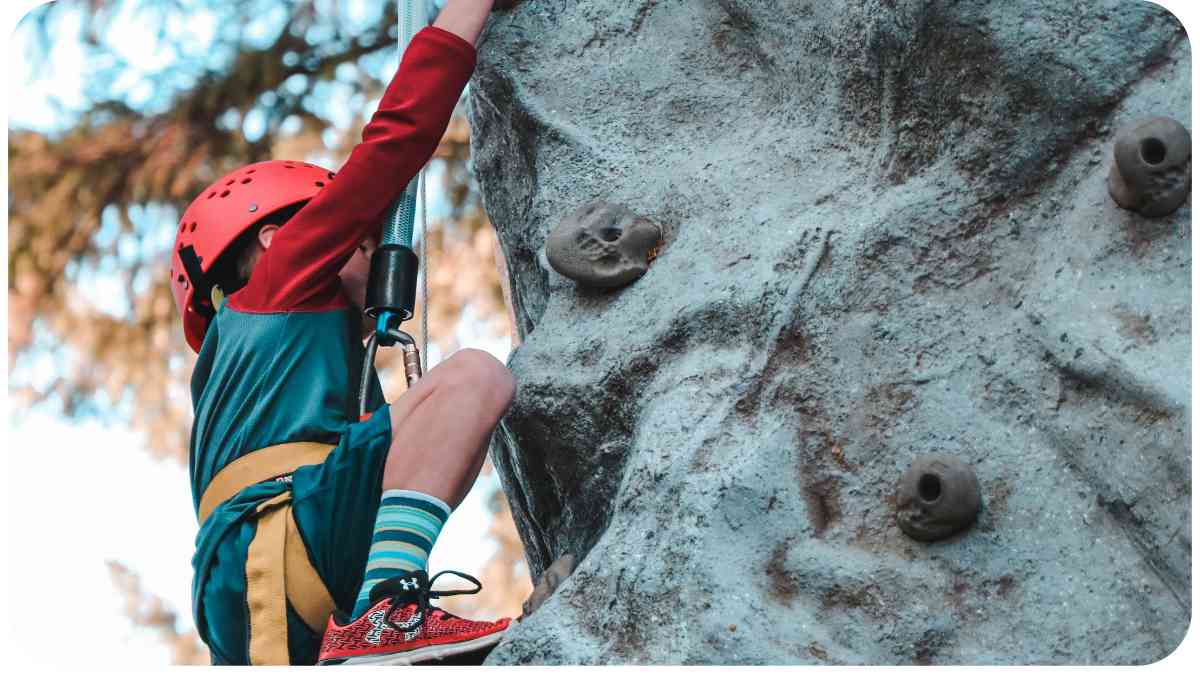In this article, we will delve into an important aspect of climbing safety: the integrity of your climbing helmet. A crack in your climbing helmet can jeopardize your safety and increase the risk of severe head injuries. Therefore, it is crucial to understand the causes behind these cracks and how to address them effectively.
| Takeaways |
| – Avoid modifications or alterations to your climbing helmet as they can compromise its structural integrity. |
| – Inspect your helmet regularly for any signs of damage, such as cracks or dents, and replace it if necessary. |
| – Store your helmet in a cool, dry place away from direct sunlight and extreme temperatures to maintain its performance. |
| – Follow the manufacturer’s guidelines for cleaning and maintenance to ensure the helmet’s effectiveness. |
| – Use your climbing helmet solely for its intended purpose and avoid using it for activities other than climbing. |
2. Understanding Climbing Helmets
Before we dive into the specific topic of cracks in climbing helmets, let’s first understand what climbing helmets are and why they are crucial for your safety.
Climbing helmets are specially designed headgear that protect climbers from falling rock, debris, and potential head injuries during climbing activities. These helmets are constructed using a combination of hard outer shells and cushioning materials on the inside.
Embark on an adrenaline-fueled journey, facing nature’s extremes and challenging your courage. Explore breathtaking summits where bravery knows no bounds.
Table 2: Types of Climbing Helmets
| Type | Description |
| Hardshell | Hardshell climbing helmets have an outer shell made of durable plastic or composite material, with foam padding on the inside. |
| Foam | Foam climbing helmets have a thick foam construction throughout, providing excellent shock absorption. |
| Hybrid | Hybrid climbing helmets combine the best features of hardshell and foam helmets, offering both durability and comfort. |
Understanding the different types of climbing helmets will help you choose the one that best suits your needs and preferences.
3. Importance of a Reliable Climbing Helmet

A reliable climbing helmet is an essential piece of equipment that can save your life in the event of a fall or impact. It provides protection to your head from falling objects, rockfall, and potential collisions with the climbing surface. It serves as a barrier between your skull and any potential hazards that may occur during climbing.
Table 3: Benefits of a Reliable Climbing Helmet
| Benefits |
| Protection against falling objects and rockfall |
| Reduced risk of head injuries |
| Increased confidence and peace of mind |
| Compliance with safety regulations and standards |
| Enhanced durability and long-term usability |
It is important to invest in a climbing helmet that meets safety standards and is recognized for its reliability and quality. Remember, your safety should always be the top priority while climbing.
4. Common Causes of Cracks in Climbing Helmets
Cracks in climbing helmets can occur due to various reasons, and it’s crucial to understand these causes to prevent potential accidents and ensure your helmet’s integrity. Here are some common causes of cracks:
When the unexpected strikes, be prepared. Learn essential mountain survival skills to navigate emergencies. Your knowledge could be the key to ensuring safety in challenging situations.
Table 4: Common Causes of Cracks in Climbing Helmets
| Cause | Description |
| Impact or Hard Falls | A significant impact, such as a hard fall or a collision with a rock surface, can lead to cracks. |
| Mishandling or Improper Storage | Dropping your helmet, storing it in extreme temperatures, or subjecting it to rough handling. |
| Age and Wear | Over time, the materials in the helmet can degrade, leading to cracks. |
| Exposure to Chemicals or Solvents | Chemicals and solvents can weaken the helmet’s structure, causing cracks. |
| Manufacturer Defects | Occasionally, manufacturing defects can lead to weakened areas and eventual cracks. |
By understanding these causes, you can take necessary precautions to prevent cracks in your climbing helmet.
5. Signs and Symptoms of a Cracked Climbing Helmet

Detecting cracks in your climbing helmet is crucial to ensure your safety. Even small cracks can compromise the helmet’s ability to protect your head effectively. Here are some signs and symptoms to look out for:
Experience comfort and safety at every ascent. Dive into the details of proper helmet fit, maximizing protection without sacrificing comfort. Elevate your climbing experience with the right helmet fit.
Table 5: Signs and Symptoms of a Cracked Climbing Helmet
| Signs and Symptoms | Description |
| Visible cracks or fissures on the surface | Inspect your helmet regularly for any visible cracks, especially in high-stress areas like the crown and sides. |
| Separation or looseness in the shell | Check if the outer shell is separated or feels loose, as this could indicate a cracked structure beneath. |
| Unusual noises or rattling inside the helmet | If you hear unusual noises or experience a rattling sensation, it could be a sign of internal cracks. |
| Reduced impact absorption | If you notice a decrease in the helmet’s ability to absorb impact or it feels different, it might be due to cracks. |
If you observe any of these signs or suspect a crack, it’s essential to take immediate action to prevent potential head injuries.
6. What to Do if You Discover a Crack in Your Climbing Helmet
Discovering a crack in your climbing helmet can be concerning, but it’s crucial not to panic. Follow these steps to address the situation appropriately:
- Inspect the Crack: Carefully examine the crack to determine its size, location, and severity. Note down these details for your reference.
- Stop Using the Helmet: As soon as you detect a crack, stop using the helmet immediately. Using a compromised helmet can increase the risk of head injuries.
- Evaluate the Severity: Some cracks may be minor and only affect the helmet’s outer shell, while others may extend through the internal structure. Evaluate the severity of the crack to determine the best course of action.
- Consult a Professional: It’s advisable to consult a professional climbing gear technician or the manufacturer of the helmet. They can provide expert advice on whether the crack can be repaired or if the helmet needs replacement.
Avoid knots and snags with expert tips on rope twist management. Unravel the complexities of rope twists, ensuring a smooth climb and enhancing safety with each ascent.
Table 6: Steps to Take if You Discover a Crack
| Steps |
| 1. Inspect the Crack |
| 2. Stop Using the Helmet |
| 3. Evaluate the Severity |
| 4. Consult a Professional |
Remember, your safety is paramount, so it’s essential to address the situation properly and seek professional guidance when necessary.
7. Evaluating the Severity of the Crack
When you discover a crack in your climbing helmet, it’s important to evaluate the severity of the damage to determine the appropriate course of action. Here are some factors to consider when assessing the severity of the crack:
- Length and Depth: Measure the length and depth of the crack. Generally, longer and deeper cracks are more concerning than smaller ones.
- Location: Pay attention to the crack’s location on the helmet. Cracks near high-stress areas, such as the crown or sides, are more critical and may require immediate action.
- Internal Structure: If possible, inspect the internal structure of the helmet. Internal cracks can significantly compromise the helmet’s integrity and impact absorption capabilities.
- Growing or Spreading: Monitor whether the crack is growing or spreading over time. If it continues to expand, it indicates a more severe structural issue.
Based on your evaluation of these factors, you can determine whether the crack is minor and repairable or if it requires immediate replacement.
Table 7: Factors for Evaluating the Severity of the Crack
| Factors for Evaluation | Description |
| Length and Depth | Measure the size of the crack to determine its severity |
| Location | Consider the crack’s position on the helmet, focusing on high-stress areas |
| Internal Structure | Inspect the internal components of the helmet for any cracks |
| Growing or Spreading | Monitor whether the crack is expanding or spreading over time |
By carefully evaluating these factors, you can make an informed decision about the necessary next steps for your climbing helmet.
Master the art of belaying and overcome common climbing safety challenges. Enhance your skills, troubleshoot problems, and ensure a secure climb. Safety is paramount in the world of climbing
8. Repairing a Cracked Climbing Helmet
Repairing a cracked climbing helmet may be possible in some cases, depending on the severity of the damage and the helmet’s construction. However, it’s essential to note that not all helmets can be repaired, and it’s crucial to prioritize your safety above all else. Here are some considerations for repairing a cracked climbing helmet:
- Manufacturer Guidelines: Refer to the manufacturer’s guidelines or contact them directly to inquire about the possibility of repairing the helmet. They will provide you with specific instructions and recommendations.
- Professional Assessment: Consult a professional climbing gear technician or a certified helmet repair specialist. They have the expertise and knowledge to assess whether the helmet can be effectively repaired without compromising your safety.
- Do-It-Yourself Repairs: In some cases, small cracks on the outer shell can be repaired using appropriate adhesives or sealants approved for helmet repairs. However, this should only be undertaken if you are confident in your abilities and have researched the proper repair methods.
Table 8: Considerations for Repairing a Cracked Climbing Helmet
| Considerations for Repair | Description |
| Manufacturer Guidelines | Follow the guidelines provided by the manufacturer regarding helmet repair procedures. |
| Professional Assessment | Seek the opinion and advice of a professional climbing gear technician or certified helmet repair specialist. |
| Do-It-Yourself Repairs | Consider attempting minor repairs on the outer shell using the appropriate adhesives or sealants, but only if you are knowledgeable and confident in your abilities. |
It is important to weigh the risks and benefits of attempting a repair. If there is any uncertainty or doubt about the effectiveness of the repair, it is advisable to err on the side of caution and replace the helmet.
9. When to Replace Your Climbing Helmet
While repairs may be possible in certain cases, there are situations where it is best to replace your climbing helmet. Here are some scenarios that warrant helmet replacement:
- Severe Damage: If the crack is extensive, deep, or extends through the shell and into the internal structure, it is typically not feasible to repair the helmet. In such cases, it is safer to replace it.
- Manufacturer Recommendations: If the manufacturer recommends replacing the helmet in the presence of cracks or certain types of damage, it is crucial to follow their guidelines. They have extensive knowledge of their product’s limitations and safety standards.
- Age and Wear: Climbing helmets have a limited lifespan, typically around 5 years. If your helmet has exceeded this recommended lifespan or shows signs of excessive wear, it is advisable to replace it to ensure optimal protection.
- Lack of Confidence: If you have any doubts about the helmet’s integrity, even after a repair attempt, it is essential to prioritize your safety and invest in a new helmet.
Table 9: Factors for Replacing a Climbing Helmet
| Factors for Replacement | Description |
| Severe Damage | If the crack is extensive, deep, or compromises the helmet’s structure, it is best to replace the helmet. |
| Manufacturer Recommendations | Follow the manufacturer’s guidelines regarding replacement, as they have expertise in their product and can provide specific recommendations. |
| Age and Wear | Replace the helmet if it has exceeded the recommended lifespan or shows signs of excessive wear and tear. |
| Lack of Confidence | If you have any doubts about the helmet’s integrity or repair, prioritize your safety and consider replacing it. |
Remember, your climbing helmet is a critical safety equipment, and it is better to invest in a new helmet than risk potential head injuries with a compromised one.
10. Tips for Preventing Cracks in Climbing Helmets
Preventing cracks in your climbing helmet is essential for maintaining its integrity and ensuring your safety. Here are some tips to help prevent cracks and prolong the lifespan of your climbing helmet:
- Handle with Care: Be mindful of how you handle your helmet, avoiding dropping it or subjecting it to rough handling. Treat it as a crucial piece of safety equipment.
- Proper Storage: Store your helmet in a cool, dry place away from direct sunlight, extreme temperatures, and chemicals. Avoid placing heavy objects on top of it.
- Avoid Impact: Try to avoid impacts and collisions with hard surfaces or other objects while wearing the helmet. Be aware of your surroundings and exercise caution.
- Regular Inspection: Regularly inspect your helmet for any signs of wear, cracks, or damage. Pay particular attention to the outer shell, internal components, and strap system.
- Follow Manufacturer Recommendations: Follow the manufacturer’s guidelines for maintenance, cleaning, and inspection. They know their product best and can provide specific instructions for long-term care.
Table 10: Tips for Preventing Cracks in Climbing Helmets
| Tips for Prevention | Description |
| Handle with Care | Handle your helmet with care, avoiding rough handling or dropping it. |
| Proper Storage | Store your helmet in a cool, dry place away from direct sunlight, extreme temperatures, and chemicals. |
| Avoid Impact | Try to avoid impacts and collisions with hard surfaces or other objects while wearing the helmet. |
| Regular Inspection | Regularly inspect your helmet for signs of wear, cracks, or damage. |
| Follow Manufacturer Recommendations | Follow the manufacturer’s guidelines for maintenance, cleaning, and inspection to ensure proper care and longevity of the helmet. |
By following these tips, you can help prevent cracks in your climbing helmet and ensure its effectiveness in protecting your head.
Conclusion
Climbing helmets are vital for protecting your head during climbing activities. Understanding the different types of helmets, the importance of a reliable helmet, and the causes and signs of cracks can help you make informed decisions about your safety.
If you discover a crack in your helmet, evaluate its severity and consult a professional or the helmet manufacturer for guidance on repair or replacement. Remember to handle and store your helmet properly and regularly inspect it to prevent cracks and ensure its longevity. By prioritizing your safety and taking proactive measures, you can enjoy climbing with peace of mind.
Further Reading
Here are some additional resources that provide valuable information about climbing helmets, their maintenance, and recognizing damage:
- 5 Ways to Screw Up Your Climbing Helmet
- This article highlights common mistakes climbers make that can compromise the effectiveness of their climbing helmets.
- Choosing Climbing Helmets
- This blog post offers guidance on selecting the right climbing helmet, considering factors such as fit, construction, and certifications.
- This Is How You Look After Your Climbing Gear and Recognize Damage
- This resource provides tips on caring for your climbing gear, including your helmet, and recognizing signs of damage or wear.
FAQs
Below are some frequently asked questions regarding climbing helmets:
Q: How often should I replace my climbing helmet?
A: It is generally recommended to replace your climbing helmet every 5 years, even if it appears undamaged. This ensures optimal protection and accounts for the natural degradation of materials.
Q: Can I use a bike helmet for climbing?
A: No, bike helmets are designed for different types of impact and may not provide adequate protection for climbing. It is important to use a helmet specifically designed and certified for climbing.
Q: Can I repair a cracked climbing helmet myself?
A: Small cracks on the outer shell may be repairable using approved adhesives or sealants, but it is recommended to consult a professional or the manufacturer for proper repair procedures. In many cases, it is safer to replace the helmet.
Q: How should I clean my climbing helmet?
A: Follow the manufacturer’s guidelines for cleaning your climbing helmet, which usually involve using mild soap and water. Avoid using any harsh chemicals or solvents that may weaken the helmet’s materials.
Q: Can I borrow or buy a used climbing helmet?
A: It is generally not recommended to use a used climbing helmet, as you cannot be sure of its history or if it has experienced damage. It is best to purchase a new helmet to ensure its integrity and your safety.

Welcome to my blog! I’m Hellen James, and I’m incredibly passionate about rock climbing, bouldering, ice climbing, and mountaineering. Join me as I embark on thrilling adventures, conquer vertical challenges, and share my experiences and insights with fellow outdoor enthusiasts.


